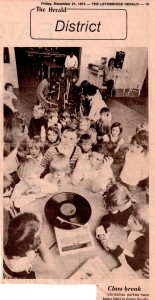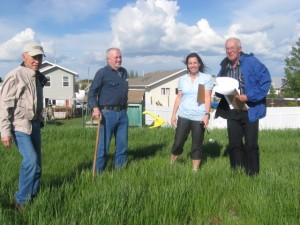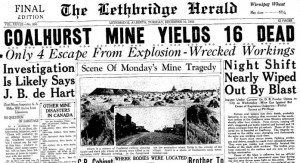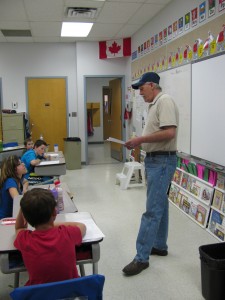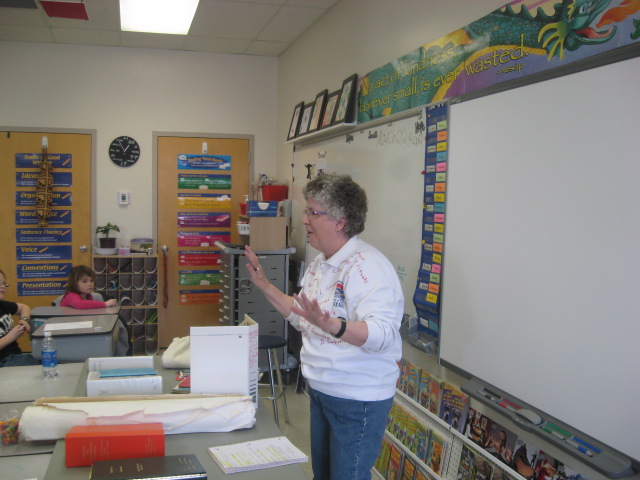We don’t know much about what it was like here 100 years ago, yet. Before we start digging, we decided to make predictions. This is what we THINK it might have been like to live here 100 years ago.

In 1913 things must have been different. I think that people still used cars; just they weren’t as good as we have now. I think Coalhurst was bigger than it is now, and even bigger than Lethbridge. Maybe homes were small; maybe the school had only one room. I think that many men were miners and women barely ever had jobs. Boys and girls must have dressed differently. There was no T.V but I think kids might have listened to the radio for fun. I think they mostly spent their time playing outside. I think families were a lot less strict but school was the opposite. I think they used telephones but the really old kind. Maybe very little people had electricity. Maybe very few had running water. I’m not sure what is was like 100 years ago but it must have been different, that is all that I know.

In 1913 things must have been different. I think there were 89 people living here. The people probably got around on horses to a grocery store in Coalhurst. I think that girls stayed at home and boys did all the work outside. I think that gas was $0.50 and if people bought a basket full of groceries it would be $10.00. I think kids would listen to the radio and play outside for the whole day. I think their bathroom was like an outhouse but cleaner. Their school was probably a little building with three classes one for preschool and kindergarten and 1-2-3 4-6. That is what I think it was like here in 1913.

Things in Coalhurst must have been different way back when 1913. That’s when Coalhurst was first incorporated. I think people possibly traveled by horse or buggy. Most people would work in the mine or on a farm. I think the schools were small or there were no schools. Teachers would be very, very strict. Homes would be so small. There would be not many businesses. Things would cost $.25 or one dollar depending on what it was. The population was possibly 2000 people. That’s what I think it was like way back when in 1913.
 In 1913 things in Coalhurst must have been different. I think people mainly rode horses around. School must have not been as safe and I also think school would be much smaller. I also believe that there were not many jobs so most people were miners. Homes were much smaller. Kids probably got entertainment from radios and things were probably much cheaper. I also think that only a couple families would have had electricity. There was not too much running water. Most clothes would be plaid shirts. I think the population was 102. The roads would be dirt. I wonder what my town was like 100 years ago?
In 1913 things in Coalhurst must have been different. I think people mainly rode horses around. School must have not been as safe and I also think school would be much smaller. I also believe that there were not many jobs so most people were miners. Homes were much smaller. Kids probably got entertainment from radios and things were probably much cheaper. I also think that only a couple families would have had electricity. There was not too much running water. Most clothes would be plaid shirts. I think the population was 102. The roads would be dirt. I wonder what my town was like 100 years ago?
 In 1913 things in Coalhurst must of have been different. I think the population was 85 people. I think lots of people worked in the mine. People might have used a radio for TV. I think the grain elevator was used for processing grain. People used to walk around and used horses. People used telegraph for communication. Kids probably played outside all day and came home for lunch. There was probably a grocery store and motel. This is what I think it was like here in 1913.
In 1913 things in Coalhurst must of have been different. I think the population was 85 people. I think lots of people worked in the mine. People might have used a radio for TV. I think the grain elevator was used for processing grain. People used to walk around and used horses. People used telegraph for communication. Kids probably played outside all day and came home for lunch. There was probably a grocery store and motel. This is what I think it was like here in 1913.
 In 1913 things in Coalhurst must have been different. I think people traveled by Model T’s and buggies. School was probably small and strict. I think for jobs the most common were store owners, car washers and doctors. Most food would cost only a few cents. Passing a ball around or riding your bike was probably fun. The houses were probably small and you didn’t get your own room. I think the population was around 80 people. This town has gone through many changes but I like the way it is now!
In 1913 things in Coalhurst must have been different. I think people traveled by Model T’s and buggies. School was probably small and strict. I think for jobs the most common were store owners, car washers and doctors. Most food would cost only a few cents. Passing a ball around or riding your bike was probably fun. The houses were probably small and you didn’t get your own room. I think the population was around 80 people. This town has gone through many changes but I like the way it is now!
 In 1913 things in Coalhurst must have been different. I think all but the richest rode horses and the rich drove Model T’s. I think girls wore long dresses and boy wore suspenders and shirts. A candy store, a restaurant and a convenience store were here. The kids played on the playground with friends most of the day. At school if people talked they would get the strap and it would be one room. The homes would be small and made out of bricks or wood. In 1913 stuff was probably a lot different.
In 1913 things in Coalhurst must have been different. I think all but the richest rode horses and the rich drove Model T’s. I think girls wore long dresses and boy wore suspenders and shirts. A candy store, a restaurant and a convenience store were here. The kids played on the playground with friends most of the day. At school if people talked they would get the strap and it would be one room. The homes would be small and made out of bricks or wood. In 1913 stuff was probably a lot different.
 In 1913 things in Coalhurst must have been different. I think that most people traveled by horseback. I think that school wasn’t as good as it is today. I think that kids played with sticks, stones and dirt. I I think that instead of running water people just got a bucket and ran to a fresh water river. I think the population was somewhere around 509 people. I think that electricity was only for very rich people. I might not have been around way back then but I know that I would rather live right now than 100 years ago.
In 1913 things in Coalhurst must have been different. I think that most people traveled by horseback. I think that school wasn’t as good as it is today. I think that kids played with sticks, stones and dirt. I I think that instead of running water people just got a bucket and ran to a fresh water river. I think the population was somewhere around 509 people. I think that electricity was only for very rich people. I might not have been around way back then but I know that I would rather live right now than 100 years ago.
 In 1913 things in Coalhurst must have been different. I think they would drive horse and buggy. Schooling would probably be in one room and I think the school would probably be somewhere else. I think gas would be way cheaper and the groceries would probably be too. If you had a full cart of groceries I think it might have been around $60. The population might have been 60 people. I think kids would play in mud and would probably be at home most of the time. I think the parents where stricter for the kids to stay home more. I think the houses might have been made out of bricks. They would have communicated with cans and string. I think I would not like to live back then!
In 1913 things in Coalhurst must have been different. I think they would drive horse and buggy. Schooling would probably be in one room and I think the school would probably be somewhere else. I think gas would be way cheaper and the groceries would probably be too. If you had a full cart of groceries I think it might have been around $60. The population might have been 60 people. I think kids would play in mud and would probably be at home most of the time. I think the parents where stricter for the kids to stay home more. I think the houses might have been made out of bricks. They would have communicated with cans and string. I think I would not like to live back then!

In 1913 things in Coalhurst must have been different. I think that children must have worked more because there were few machines. School must have been more strict to keep kids in line. I think kids walked to school from close farms. I think there were no cell phones if you wanted to call while in town you would have to call from a store. I think kids would have few toys to play with. After it rained they would play in the mud. I think kids would have had less time to play because they would be busy with chores.
 In 1913 things in Coalhurst must have been different. I think the school was a small schoolhouse with no playground. I think they rode on horse and buggy, and some people had cars like Model T’s. I think they had a hospital, a bakery, a gas station, and a small store. I think the houses were small and made of sticks or mud and some people had houses made brick. Maybe bread cost $0.01 a loaf. We might have had a few hundred people. Some people might have lived here because of the mine. I think they used a hole in the ground for a bathroom. They might do their homework, go with friends, explore nature, or even listen to the radio for fun. Maybe they had LONG family talks. Things sure have changed a lot since 1913.
In 1913 things in Coalhurst must have been different. I think the school was a small schoolhouse with no playground. I think they rode on horse and buggy, and some people had cars like Model T’s. I think they had a hospital, a bakery, a gas station, and a small store. I think the houses were small and made of sticks or mud and some people had houses made brick. Maybe bread cost $0.01 a loaf. We might have had a few hundred people. Some people might have lived here because of the mine. I think they used a hole in the ground for a bathroom. They might do their homework, go with friends, explore nature, or even listen to the radio for fun. Maybe they had LONG family talks. Things sure have changed a lot since 1913.

In 1913 things in Coalhurst must have been different. I think people traveled on trains and the school was by the train tracks. The population was around 1000. I think there were businesses like motels and grocery stores. The homes were small and the jobs paid not that much money. I think kids could run around everywhere and their parents did not care as much as today. I think the women worked as maids and the men mined. They had no electricity and the bathrooms were outhouses. Gas I think would be like a dollar to fill your tank. This is what I think Coalhurst has like in 1913.
 In 1913 things in Coalhurst must have been different. I think people got around on horse but rich people had cars. I think a car was like 20 dollars and a full tank of gas was 2 dollars maybe. Kids probably got in trouble more and they walked everywhere or rode on a bike. I think the school was at a different location. There were three rooms one for preschool to kindergarten, one for grade 1-3 and then another one for grades 4 to 6. I think the homes were two bedroom and one bathroom. Man, I really hope things don’t go back to what they were like back then!
In 1913 things in Coalhurst must have been different. I think people got around on horse but rich people had cars. I think a car was like 20 dollars and a full tank of gas was 2 dollars maybe. Kids probably got in trouble more and they walked everywhere or rode on a bike. I think the school was at a different location. There were three rooms one for preschool to kindergarten, one for grade 1-3 and then another one for grades 4 to 6. I think the homes were two bedroom and one bathroom. Man, I really hope things don’t go back to what they were like back then!
 In 1913 things in Coalhurst must have been different. I think that most of the people here were coal miners. Also the coal miners might have rode horses to work. Some of the businesses might have been a bank, a gas station, a restaurant, a post office, a pub, a mining and an old fashioned corner store. Maybe the people that weren’t miners had a hard time finding jobs. Thinking of that I wonder how schools were back then. Also I wonder how strict and mean the teachers were. I think the population was about 100 people. Also I think the homes were made out of wood, brick and were stinky and also to shower they used buckets of water and the toilets were holes in the ground. That’s what I think Coalhurst was like in 1913.
In 1913 things in Coalhurst must have been different. I think that most of the people here were coal miners. Also the coal miners might have rode horses to work. Some of the businesses might have been a bank, a gas station, a restaurant, a post office, a pub, a mining and an old fashioned corner store. Maybe the people that weren’t miners had a hard time finding jobs. Thinking of that I wonder how schools were back then. Also I wonder how strict and mean the teachers were. I think the population was about 100 people. Also I think the homes were made out of wood, brick and were stinky and also to shower they used buckets of water and the toilets were holes in the ground. That’s what I think Coalhurst was like in 1913.
 In 1913 things in Coalhurst must have been different. I think people traveled mostly by foot and some by horseback. Most houses were probably made out of wood or out of brick. I think there might have been a pub or a hotel in the town. I think the elevator on highway three might have been a grain elevator. It might not even have been there. Back then I bet things were really cheap. Yup, things were very different back then.
In 1913 things in Coalhurst must have been different. I think people traveled mostly by foot and some by horseback. Most houses were probably made out of wood or out of brick. I think there might have been a pub or a hotel in the town. I think the elevator on highway three might have been a grain elevator. It might not even have been there. Back then I bet things were really cheap. Yup, things were very different back then.
 In 1913 things in Coalhurst must have been different. I think people got around on horse and bikes. I think the old, old, old school was small, but had 3 floors. I also think that stores sold stuff that isn’t expensive to us but was to them. I think kids played with rocks, sticks and mud. The population was probably around 62. The most popular job was most likely coal mining. I think houses were made of wood and occasionally cement. I also think teachers were stricter. Boys and girls must have dressed differently. A LOT of things have changed since 1913!!
In 1913 things in Coalhurst must have been different. I think people got around on horse and bikes. I think the old, old, old school was small, but had 3 floors. I also think that stores sold stuff that isn’t expensive to us but was to them. I think kids played with rocks, sticks and mud. The population was probably around 62. The most popular job was most likely coal mining. I think houses were made of wood and occasionally cement. I also think teachers were stricter. Boys and girls must have dressed differently. A LOT of things have changed since 1913!!
 Many things were very different back in 2013 compared to now. I do not think they had televisions or radios. They probably had to play games like tag and kick the can for fun. They might not have had playgrounds to play in but they could have had horses to ride and might have played baseball. Most me would have been minders. They probably worked hard for their familis. I think many other languages were spoken because people came here from other countries. I don’t think many people had cars so they had to walk everywhere. There was probably no running water or electricity either. I don’t think I would have like to live back then. I would miss my T.V.
Many things were very different back in 2013 compared to now. I do not think they had televisions or radios. They probably had to play games like tag and kick the can for fun. They might not have had playgrounds to play in but they could have had horses to ride and might have played baseball. Most me would have been minders. They probably worked hard for their familis. I think many other languages were spoken because people came here from other countries. I don’t think many people had cars so they had to walk everywhere. There was probably no running water or electricity either. I don’t think I would have like to live back then. I would miss my T.V.
 As a child living in Coalhurst in 2012 I can’t imagine what it was like in 1913. I think the kids then played in tents made with the blankets and sticks. There was a police station in town. I think kids walked a lot in 1913. Adults probably traveled by horse and buggy. Swimming was probably a fun summer activity and I think the people would swim in the river not in swimming pools. I think things would have been a lot harder back then and I am very happy to live in 2012!
As a child living in Coalhurst in 2012 I can’t imagine what it was like in 1913. I think the kids then played in tents made with the blankets and sticks. There was a police station in town. I think kids walked a lot in 1913. Adults probably traveled by horse and buggy. Swimming was probably a fun summer activity and I think the people would swim in the river not in swimming pools. I think things would have been a lot harder back then and I am very happy to live in 2012!

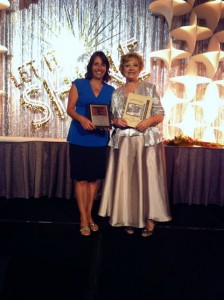
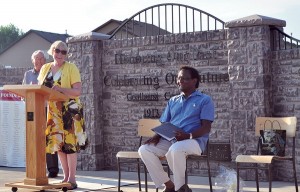







 Vera Schwartkopf, Lawrence Watmough, Al Duncan, Charles Wesselman and Fiona Denhoed joined Mrs. Lenz and her 2-3 class and Mr. Bryant’s grade 6 class to celebrate Coalhurst’s 99th birthday with a song and cupcakes on December 17th. Each of the guests had a chance to share one more story with the students. Mr. Wesselman told us about being in grade 3 and having pneumonia so bad that he had to go into the Coalhurst hospital, where they drained his lungs. Two other youngsters were in the hospital at the same time he was. He noted that this treatment for pneumonia is no longer practiced. Mrs. Denhoed told the students a story about how their teacher, Mrs. Lenz (her daughter) got stuck in the mud in front of her house in Coalhurst. There were no sidewalks on the west side of Coalhurst until the 1980’s.
Vera Schwartkopf, Lawrence Watmough, Al Duncan, Charles Wesselman and Fiona Denhoed joined Mrs. Lenz and her 2-3 class and Mr. Bryant’s grade 6 class to celebrate Coalhurst’s 99th birthday with a song and cupcakes on December 17th. Each of the guests had a chance to share one more story with the students. Mr. Wesselman told us about being in grade 3 and having pneumonia so bad that he had to go into the Coalhurst hospital, where they drained his lungs. Two other youngsters were in the hospital at the same time he was. He noted that this treatment for pneumonia is no longer practiced. Mrs. Denhoed told the students a story about how their teacher, Mrs. Lenz (her daughter) got stuck in the mud in front of her house in Coalhurst. There were no sidewalks on the west side of Coalhurst until the 1980’s.









